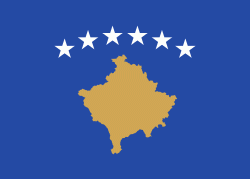Kosovska Mitrovica (Mitrovicë)
 |
In 2013, following the North Kosovo crisis, the Serb-majority municipality of North Mitrovica was created, dividing the city in two administrative units. According to the 2011 Census, in Mitrovica live 97,686 inhabitants, 85,360 of which in the southern municipality and 12,326 in North Mitrovica.
The name of Mitrovica derives from the name Demetrius. It was most probably named after the 8th century Byzantine church St. Demetrius which was built near Zvečan Fortress, just above the modern Mitrovica, in honor of Saint Demetrius of Thessaloniki. The city was called D(i)mitrovica until it fell under the Ottoman rule.
In 1660, the Ottoman explorer Evliya Çelebi mentions for the first time the city with the name Mitrovica.
After President Tito's death, each of the constituent parts of Yugoslavia had to have one place named with the word "Tito" (or "Tito's") included, the city was then known as Titova Mitrovica (Титова Митровица) in Serbian or Mitrovica e Titos in Albanian, until 1991.
Map - Kosovska Mitrovica (Mitrovicë)
Map
Country - Kosovo
 |
 |
In classical antiquity, the central tribe which emerged in the territory of Kosovo were the Dardani, who formed an independent polity known as the Kingdom of Dardania in the 4th century BC. It was annexed by the Roman Empire by the 1st century BC, and for the next millennium, the territory remained part of the Byzantine Empire, whose rule was eroded by Slavic invasions beginning in the 6th–7th century AD. In the centuries thereafter, control of the area alternated between the Byzantines and the First Bulgarian Empire. By the 13th century, Kosovo became the core of the Serbian medieval state, and has also been the seat of the Serbian Orthodox Church from the 14th century, when its status was upgraded to a patriarchate. Ottoman expansion in the Balkans in the late 14th and 15th century led to the decline and fall of the Serbian Empire; the Battle of Kosovo of 1389 is considered to be one of the defining moments in Serbian medieval history. The Ottomans fully conquered the region after the Second Battle of Kosovo. The Ottoman Empire ruled the area for almost five centuries until 1912.
Currency / Language
| ISO | Language |
|---|---|
| SQ | Albanian language |
| SR | Serbian language |















